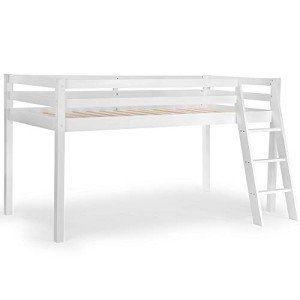Exploring Bunk Beds: A Comprehensive Guide
Bunk beds have long been a staple in kids's bed rooms, dorms, and even homes with limited space. Not just do they supply a useful sleeping service, but they likewise produce a fun and creative environment for kids and a great space-saver for adults and households. This article will explore everything you need to understand about bunk beds, from types and products to safety suggestions and purchasing advice.
Tabulation
- Kinds Of Bunk Beds
- Traditional Bunk Beds
- Loft Beds
- Triple Bunk Beds
- L-Shaped Bunk Beds
- Material Options
- Wood
- Metal
- Security Considerations
- Purchasing Guide
- Frequently asked questions
Kinds Of Bunk Beds
Bunk beds come in numerous designs to fit various needs and preferences. Here's a breakdown of the most common types:
Conventional Bunk Beds
Conventional bunks generally feature 2 beds stacked vertically on top of one another. These beds are perfect for siblings sharing a room or for optimizing sleeping space in guest spaces.
Loft Beds
Loft beds stand similarly to standard bunk beds however do not have a lower sleeping area. Rather, they typically incorporate a desk or seating location beneath, making them a great choice for small rooms needing multifunctionality.
Triple Bunk Beds
Triple bunk beds are developed for 3 occupants, with beds stacked in a three-tier setup. These are less common but can be a fun service for large households or slumber parties.
L-Shaped Bunk Beds
With one bed positioned horizontally and the other vertically, L-shaped bunk beds are often geared up with additional features such as desks or storage drawers and can match corner areas in a room.
Comparison of Bunk Bed Types
| Bed Type | Perfect Use | Description |
|---|---|---|
| Traditional | Shared bedrooms or guest spaces | Two beds stacked vertically |
| Loft | Little spaces needing multi-purpose space | Upper bed with open space below |
| Triple | Large households or sleepovers | Three beds stacked vertically |
| L-Shaped | Corner or versatile areas | A mix of vertical and horizontal beds |
Product Options
Bunk beds are produced from numerous products, with wood and metal being the most typical. Each product has its advantages and disadvantages.
Wood
- Sturdiness: Generally robust and can endure years of use.
- Visual Appeal: Offers a classic appearance that can blend with numerous decors.
- Weight Capacity: Typically sturdier; can support much heavier weights.
- Drawbacks: May be more pricey than metal choices and can be prone to scratches.
Metal
- Durability: Generally lightweight and easy to move but still tough.
- Modern Design: Often is available in smooth designs, making it appealing for modern spaces.
- Cost-Effective: Usually less expensive than wooden alternatives.
- Drawbacks: Can be cold to the touch in winters and might not have the same visual appeal for some purchasers.
Safety Considerations
When it pertains to bunk beds, security can not be ignored. Here are crucial safety pointers to keep in mind:
- Guardrails: Ensure that the leading bunk has guardrails on both sides to avoid falls.
- Sturdy Construction: Check for a solid construct and strong products to endure weight and motion.
- Weight Limit: Adhere to the manufacturer's weight limitation for both the upper and lower bunks.
- Ladder Design: Choose bunks with a safe, easy-to-climb ladder and prevent any sharp edges or rungs.
- Age Restrictions: Most makers recommend that kids under the age of 6 need to not sleep in the upper bunk.
Buying Guide
When searching for bunk beds, consider the following elements to discover the best suitable for your requirements:
- Space Availability: Measure the room size and ceiling height, ensuring there is appropriate space for the leading bunk.
- Bed Size: Decide between twin, complete, or larger sizes based upon your requirements and the size of the room.
- Design Preference: Consider the total decoration of the bedroom to discover a suitable style.
- Relieve of Setup: Look for a bunk bed that is straightforward to put together.
- Budget: Bunk beds come in different rate ranges, so figure out a budget before starting your search.
FAQs
1. What is the advised age for children to sleep on the top bunk?
Children aged 6 and older are typically advised to sleep on the top bunk to minimize the threat of falls.
2. How can I make my bunk bed much safer?
To boost safety, ensure guardrails are correctly installed and check that the bed is put on a flat surface area. Furthermore, Bunk Beds Children's to utilize the ladder carefully.
3. Can I convert a bunk bed into two different beds?
Numerous bunk beds are designed to be convertible. Examine the maker's requirements for convertibility features.
4. What accessories are readily available for bunk beds?
Typical devices include beddings, storage drawers, staircases instead of ladders, and tented canopies for an enjoyable visual appeal.
5. How do I preserve my bunk bed?
Regular checks for loose screws or structural stability can assist guarantee security. Dust the bed routinely and clean spills promptly to keep the products in good condition.
Bunk beds are flexible and a space-efficient option for various living situations, from kids's rooms to visitor accommodations. With numerous designs and materials available, prospective buyers have a wealth of options to think about, guaranteeing a combination of functionality and looks. By prioritizing security and following the suggestions laid out in this guide, individuals can discover the ideal bunk bed that suits their space and way of life, all while developing a satisfying sleeping environment.

